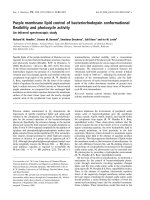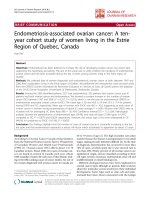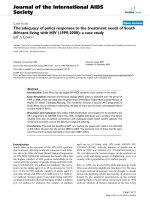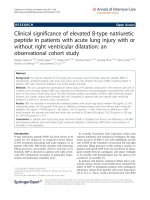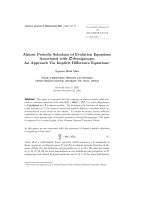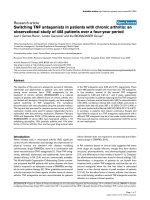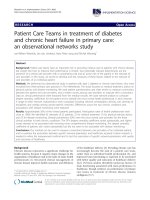Lesion distribution characteristics of deep infiltrating endometriosis with ovarian endometrioma: An observational clinical study
Bạn đang xem bản rút gọn của tài liệu. Xem và tải ngay bản đầy đủ của tài liệu tại đây (488.64 KB, 7 trang )
Kwok et al. BMC Women's Health
(2020) 20:111
/>
RESEARCH ARTICLE
Open Access
Lesion distribution characteristics of deep
infiltrating endometriosis with ovarian
endometrioma: an observational clinical
study
Hungling Kwok1, Hongye Jiang2, Tian Li1, Huan Yang3, Hui Fei1, Li Cheng1, Shuzhong Yao2 and Shuqin Chen2*
Abstract
Background: To investigate the characteristics of deep infiltrating endometriosis (DIE) lesion distribution when
associated with ovarian endometrioma (OEM).
Methods: The present study analyzed retrospective data obtained by the First Affiliated Hospital of Sun Yat-sen
University, between June 2008 to June 2016. A total of 304 patients underwent laparoscopic surgery for complete
removal of endometriosis by one experienced surgeon, and histological confirmation of OEM associated with DIE
was conducted for each patient. Clinical data were recorded for each patient from medical, operative and
pathological reports. Patients were then divided into two groups according to unilateral or bilateral OEM. Patients
with unilateral OEM were subsequently divided into two subgroups according to OEM location (left- or right-hand
side) and the diameter of the OEM (≤50 and > 50 mm). The distribution characteristics of DIE lesions were then
compared between the groups.
Results: DIE lesions were widely distributed, 30 anatomical sites were involved. Patients with associated unilateral
OEM (n = 184 patients) had a significantly increased number of DIE lesions when compared with patients with
bilateral OEM (n = 120 patients; 2.76 ± 1.52 vs. 2.33 ± 1.34; P = 0.006). Compared with bilateral OEM with DIE, there
was a higher rate of intestinal (39.1% vs. 18.3%; P < 0.01) and vaginal (17.4% vs. 6.7%; P < 0.01) infiltration by DIE
lesions in unilateral OEM with DIE. The mean number of DIE lesions was not significantly correlated with the
location or size of the OEM (2.83 ± 1.56 vs. 2.74 ± 1.53; P = 0.678; and 2.65 ± 1.42 vs. 2.80 ± 1.43; P = 0.518,
respectively). There was no significant difference between the groups with OEM ≤50 mm and > 50 mm.
Conclusion: Lesion distribution characteristics in women diagnosed with histologically proven OEM associated with
DIE were frequently multifocal and severe.
Keywords: Ovarian endometrioma, Deep infiltrating endometriosis, Lesion distribution characteristics
Background
Endometriosis is a common benign diseases of women of
childbearing age [1]. According to histology,
* Correspondence:
2
Department of Obstetrics and Gynecology, the First Affiliated Hospital, Sun
Yat-sen University, Guangzhou 510000, China
Full list of author information is available at the end of the article
endometriosis is characterized into three main types:
superficial endometriosis, ovarian endometrioma and deep
infiltrating endometriosis (DIE) [2]. DIE is an aggressive
form of the disease, penetrating to more than 5 mm under
the peritoneal surface [3].DIE is associated with infertility
and a variable degree of pelvic pain. It is a multifocal disease primarily affecting the posterior area, and frequently
© The Author(s). 2020 Open Access This article is licensed under a Creative Commons Attribution 4.0 International License,
which permits use, sharing, adaptation, distribution and reproduction in any medium or format, as long as you give
appropriate credit to the original author(s) and the source, provide a link to the Creative Commons licence, and indicate if
changes were made. The images or other third party material in this article are included in the article's Creative Commons
licence, unless indicated otherwise in a credit line to the material. If material is not included in the article's Creative Commons
licence and your intended use is not permitted by statutory regulation or exceeds the permitted use, you will need to obtain
permission directly from the copyright holder. To view a copy of this licence, visit />The Creative Commons Public Domain Dedication waiver ( applies to the
data made available in this article, unless otherwise stated in a credit line to the data.
Kwok et al. BMC Women's Health
(2020) 20:111
involves the uterosacral ligament, uterine rectum pouch
and vaginal rectal diaphragm, as well as the bladder, ureter
and rectal wall [4].
For patients with multifocal characteristics of DIE,
meaningful improvements in clinical symptoms and
quality of life are dependent on the radical exeresis of
the lesions [5, 6]. When surgical treatment has been recommended, an accurate diagnosis and knowledge of the
precise distribution of the extending lesions are required
[4]. However, there are currently no adequately sensitive
and specific symptoms nor diagnostic tests for the clinical diagnosis of DIE. The perfect solution would be to
utilize a preoperative label for the distribution of DIE to
generate a precise map of the DIE lesions.
Ovarian endometrioma (OEM) is the most common
type of endometriosis, ~ 50% of DIE patients are also diagnosed with OEM [7]. Previous studies have demonstrated that associated OEM is a marker for greater DIE
severity. Compared with patients without OEM, patients
with OEM have more pelvic and intestinal areas involved by DIE [8, 9]. In case of OEM, severe pelvic pain
is significantly associated with DIE [10]. Indeed, Perello
et al. [11] created a predictive model to predict DIE in
patient with OEM. However, these studies do not refer
to the characteristics of the lesion distribution in OEM
patients with DIE. Therefore, the present study investigated OEM in order to determine the lesion distribution
characteristics of DIE associated with OEM.
Methods
Page 2 of 7
past history of surgical treatment for endometriosis, pain
symptoms and other specific symptoms. Pain symptoms
included dysmenorrhea, dyspareunia, chronic pelvic
pain, and bowel pain. Other specific symptoms including
hematochezia, urinary frequency and urgency, and
hydro-nephrosis. Histological confirmation was obtained
for all endometriotic lesions and a description of the location of the DIE lesions was recorded.
All of the patients underwent extensive preoperative
tests, including clinical examinations, transvaginal sonography, urological ultrasound and MRI. Patients were
treated surgically due to ineffective conservative treatment or serious complications. All of the operations
were performed by an experienced surgeon (Professor
Shuzhong Yao). All visible endometriosis lesions, including ovarian endometrioma and DIE lesions, were surgically removed. For patients with adenomyosis, local
resection or hysterectomy was performed according to
the severity of the disease and bearing requirement. In
addition to DIE resection, surgical treatment involves
adhesion separation as well as resection and reconstruction of the urinary organs and bowel. When these procedures were employed, urologists and gastroenterologists
were necessary. Patients were divided into two groups
according to the type OEM: unilateral or bilateral. Patients with unilateral OEM were subsequently divided
into subgroups according to the location of the OEM
(left- or right-hand side) and the diameter of the OEM
(≤50 and > 50 mm). The distribution characteristics of
DIE lesions were then compared between the groups.
Patients
The present retrospective study was approved by the Institutional Review Board of the First Affiliated Hospital of
Sun Yat-sen University (Guangzhou, China). All patients
provided written informed consent. A total of 304 consecutive patients underwent laparoscopic surgery for
complete removal of endometriosis in the First Affiliated
Hospital of Sun Yat-sen University, between June 2008 to
June 2016; histological confirmation of OEM associated
with DIE was conducted for each patient. Histological
diagnoses were based on characteristics previously defined
in a standard histological description, comprised of a combination of endometrial glands and stroma [12].
The exclusion criteria were as follows: i) laparoscopic
surgery converted to open surgery; ii) lack of histological
confirmation of endometriosis; iii) previous history of
hysterectomy or oophorectomy; and iv) patients with
pelvic malignant tumors.
Between June 2008 to June 2016, clinical data were recorded retrospectively for each patient from medical, operative and pathological reports; data were blinded for
examination by two of the authors. For each patient,
general data were recorded, including age, parity, the
diameter and location of the OEM (right or left), and
Statistical analysis
Statistical analysis was performed using SPSS version
23.0 for Windows (IBM Corp., Armani, NY, USA). P <
0.05 was considered to indicate a statistically significant
difference. Statistical analysis was conducted stepwise
after assessing quantitative variable distributions. Statistical studies using parametric tests were only conducted
after checking the normal distribution of the studied
variables. Correlations between qualitative variables were
analyzed by a Pearson’s chi-square test. In case of significant reciprocal correlation, the relative risk was calculated with 95% confidence intervals.
Results
Patient characteristics are presented in Table 1. A total
of 304 patients were included in the present study. The
female patients had a mean age of 34.2 ± 5.8 (range, 17–
49) years. All the patients with OEM associated with
DIE have different symptoms. According to the different
symptoms, they were divided into two types: nonspecific symptoms and specific symptoms. Non-specific
symptoms include dysmenorrhea (89.5%), dyspareunia
(12.8%) and chronic pelvic pain (4.3%), while specific
Kwok et al. BMC Women's Health
(2020) 20:111
Page 3 of 7
Table 1 Preoperative characteristics of the study population
a
Patients’ characteristics (N = 304)
Values
Age(years)
34.2 ± 5.8(range17–49)
Table 2 The prevalence of anatomical distribution of DIE
lesions. (n = 304 patients)
Main lesiona
Uterosacral ligament
Parity
Number of patients(%)b
245(80.6)
Para≥1
158(52.0%)
Left
Nulliparous
146(48.0%)
Right
53
78(25.7%)
Bilateral
135
Infertility
Previous surgery for OEM
88(28.9%)
b
Presenting symptoms
57
Intestine
93(30.6)
Ureter
47(15.5)
32(10.5%)
Left
22
Dysmenorrhea
272(89.5%)
Right
18
Dyspareunia
39(12.8%)
Bilateral
7
No symptoms
Chronic pelvic pain
17(5.6%)
Vaginal
Rectal tenesmus
73(24.0%)
Posterior fornix
33(10.9)
13(4.3%)
Fallopian tube
29(9.54)
Difficulty in defecation
40(13.2)
6(2.0%)
Left
12
Defecation pain
11(3.6%)
Right
4
Hematochezia
8(2.6%)
Bilateral
13
Diarrhea
Urinary frequency and urgency
9(3.0%)
Recto-vaginal septum
Haematuria
2(0.7%)
Rectovaginal pouch
9(2.96)
26(8.6%)
Bladder
4(1.32)
Hydronephrosis
Endometrioma laterality
Left
98(32.2%)
Right
86(28.3%)
Bilateral
120(39.5%)
Endometrioma size (mm)
55.9 ± 23.9 (range10–150)
Number of DIE lesions
2.60 ± 1.5 (range1–9)
OEM, ovarian endometrioma; DIE, deep infiltrating endometriosis
a
Values are shown as mean ± standard deviation or N(%)
b
Different symptoms can be associated in the same patient
symptoms include intestinal symptoms and urinary
symptoms. Intestinal symptoms include rectal tenesmus
(24%), difficulty in defecation (4.3%), defecation pain
(3.6%), diarrhea (2.0%) and hematochezia (2.6%). Urinary
symptoms include urinary frequency and urgency (3.0%),
hematuria (0.7%) and hydronephrosis (8.6%). In the cohort of 304 patients with an associated OEM, the OEM
was located on the left-hand side in 98 patients (32.2%),
on the right-hand side in 86 patients (28.3%), and was
bilateral in 120 patients (39.5%). The mean size of the
OEM was 55.9 ± 23.9 mm (range, 10–150 mm).
The anatomical locations of the DIE lesions are presented
in Table 2. A total of 788 histologically confirmed DIE lesions were observed in the present study. The mean number
of DIE lesions per patient was 2.60 ± 1.46 (range, 1–9). DIE
lesions were widely distributed; there were 30 anatomical
sites recorded in the present study, which were mainly located in the posterior pelvic cavity. A total of 532 lesions
were recorded, of which 274 (51.5%) were located on the
21(6.91)
DIE deep infiltrating endometriosis
a
According to the location of the lesion recorded during the operation
b
Number of patients whose lesions histologically proven deep
infiltrating endometriosis
left-hand side and 258 (48.5%) on the right-hand side. The
uterosacral ligament represented the most frequent location
site with a prevalence of 80.6%, followed by the intestine
(30.6%), ureter (15.5%), vagina (13.2%), posterior fornix
(10.9%), fallopian tube (9.54%), vaginal-rectum (6.91%), rectovaginal pouch (2.96%) and bladder (1.32%). Intestinal
endometriosis includes rectum and sigmoid endometriosis.
There were also 4 cases of appendiceal endometriosis that
were not included in the intestinal endometriosis.
Patients with associated unilateral OEM (n = 184 patients) had a significantly increased number of DIE lesions when compared with patients with bilateral OEM
(n = 120 patients; 2.76 ± 1.52 vs. 2.33 ± 1.34; P = 0.006;
Table 3). Compared with bilateral OEM with DIE, a
higher rate of intestinal (39.1% vs. 18.3%; P < 0.01) and
vaginal (17.4% vs. 6.7%; P < 0.01) infiltration by DIE lesions was observed in unilateral OEM with DIE. The
mean number of DIE lesions was not significantly correlated with the location or size of the OEM (2.83 ± 1.56
vs. 2.74 ± 1.53, P = 0.678; 2.65 ± 1.42 vs. 2.80 ± 1.43, P =
0.518, respectively). There were no significant differences
between the groups with OEMs ≤50 mm and > 50 mm.
Discussion
Previous studies have revealed that, for patients with histologically confirmed DIE, an associated ovarian OEM is
Kwok et al. BMC Women's Health
(2020) 20:111
Page 4 of 7
Table 3 Characteristics of deeply infiltrating endometriosis lesion distribution associated ovarian endometrioma
Variables
Pvalue
Comparison
OEM lateralitya
Number of DIE lesions
Unilateral n = 184(%)
Bilateral n = 120(%)
2.76 ± 1.52
2.33 ± 1.34
OR
95% CI
0.006*
Uterosacral ligament
151(82.1)
94(78.3)
0.421
1.266
0.712–2.249
Intestine
72(39.1)
21(17.5)
0.000*
3.031
1.738–5.286
*
Vagina
32(17.4)
8(6.70)
0.007
2.947
1.308–6.641
Posterior fornix
23(12.5)
10(8.3)
0.100
1.571
0.720–3.431
Ureter
29(15.8)
18(15.0)
0.858
1.060
0.560–2.009
Fallopian tube
19(10.3)
10(8.3)
0.563
1.267
0.568–2.827
Rectovaginal pouch
16(8.7)
14(11.7)
0.396
0.767
0.359–1.637
Side of OEMa
Number of DIE lesions
Left side n = 98(%)
Right side n = 86(%)
2.83 ± 1.56
2.74 ± 1.53
0.678
Uterosacral ligament
81(82.7)
70(81.4)
0.824
1.089
0.512–2.315
Intestine
40(40.8)
32(37.2)
0.617
1.164
0.642–2.109
Vagina
18(18.4)
15(17.4)
0.870
1.065
0.500–2.268
Posterior fornix
15(15.3)
8(9.3)
0.219
1.762
0.078–4.386
Ureter
16(16.3)
13(15.1)
0.822
1.096
0.494–2.431
Fallopian tube
8(8.2)
11(12.8)
0.303
0.606
0.232–1.584
Rectovaginal pouch
9(9.2)
7(8.1)
0.802
1.141
0.406–3.207
Unilateral OEM sizea
Number of DIE lesions
≤50 mm n = 112(%)
> 50 mm n = 72(%)
2.77 ± 1.4
2.82 ± 1.4
0.960
Uterosacral ligament
87(77.7)
64(88.9)
0.053
0.435
0.184–1.027
Intestine
54(48.2)
17(23.6)
0.001*
3.012
1.560–5.817
Vagina
25(22.3)
6(8.3)
0.013*
3.161
1.226–8.164
Posterior fornix
11(9.8)
12(16.7)
0.171
0.545
0.226–1.311
Ureter
15(13.4)
14(19.4)
0.272
0.641
0.289–1.423
Fallopian tube
10(8.9)
9(12.5)
0.437
0.686
0.264–1.781
Rectovaginal pouch
11(9.8)
12(16.7)
0.171
0.545
0.226–1.311
Values are shown as mean ± standard deviation or N(%)
*
Statistically significant
a
a marker for the severity of the disease [8]. However, the
related research on the distribution characteristics of the
DIE lesions in patients with OEM is still limited. The
present study investigated lesion distribution characteristics in women diagnosed with histologically confirmed
OEM and DIE, as this combined diagnosis is often indicative of a more multifocal and severe disease. There
was a greater frequency of anatomic DIE lesion sites in
patients with unilateral OEM (unilateral OEM size ≤50
mm) than in patients with bilateral OEM (unilateral
OEM size ≤50 mm), and DIE lesions were often associated with intestinal and vaginal infiltration.
These data suggested that DIE lesions were widely distributed. There were 30 anatomical sites observed in the
present study, which were primarily located in the posterior pelvic cavity, but also in the uterosacral ligaments,
intestines, ureter, vagina, posterior fornix and rectovaginal pouch. The distribution of DIE lesions was associated with the flow pattern of peritoneal fluid and the
morphology of the pelvic cavity [13]. When compared
with the uterosacral ligaments, intestines and vagina, the
reduced frequency of deep bladder endometriosis observed can be explained by anatomical location as the
lower limit of the vesico-uterine pouch is located well
above the lower limit of the Pouch of Douglas [14]. The
anatomical differences between the left- and right-hand
sides of the hemipelvis are that the sigmoid colon is located on the left-hand side of the hemipelvis, and when
Kwok et al. BMC Women's Health
(2020) 20:111
combined with the left adnexa it forms a barrier to prevent menstrual blood reflux, resulting in an anatomical
situation that could promote adhesions and the growth
of refluxed endometrial cells on the left-hand side of the
pelvic wall [15].
According to the literature, intestinal endometriosis
and urinary tract endometriosis account for ~ 5–12%
and 0.3–12%, respectively, of all women with endometriosis [16–18]. However, in the present study, intestinal
endometriosis accounted for 30.9%, and urinary tract
endometriosis accounted for 15.2% of cases, which are
greater frequencies than those recorded by previous research. According to the theory of Kondo et al., women
presenting with OEM had a stronger association with
the presence of DIE lesions and intestinal DIE [19].
There is lack of research on OEM associated with urinary tract endometriosis. The present results indicated
that, for patients diagnosed with histologically verified
OEM associated with DIE, there was an increased risk of
lesions involving the intestine and ureter. Thus, when
the clinical examination suggests OEM with DIE, the
practitioner should search for severe lesions, especially
intestinal and ureteral lesions. Surgery for intestinal
endometriosis and urinary endometriosis is difficult,
with a number of postoperative complications [20, 21].
The literature reports distinguish between major and
minor complications. Major complications include anastomotic insufficiencies, intestinal perforation, retovaginal
fistulas, severe infections, and bleeding requiring transfusion, which are reported in 7.4% [22] to 25% [23]. Minor
complications include slight-to-moderate infections, peripheral sensory disturbances, bladder voiding dysfunction, and postoperative urinary obstruction, which are
reported in 0.6% [24] to 57% [25]. Therefore, full clinical
evaluations, as aforementioned, before operating may be
very important for OEM patients with DIE.
As mentioned above, intestinal endometriosis refers to
the rectum and sigmoid endometriosis. However, there
are a special intestinal endometriosis, appendiceal endometriosis, which is considered as an uncommon finding,
in the literature its prevalence varies widely [26]. In our
study, there are 4 patients with appendiceal endometriosis
, are responsible for approximately 4% of all intestinal lesions. Mabrouk et al. [27] pointed out that appendiceal
endometriosis was associated with adenomyosis, large
right endometrioma, deep posterior pelvic endometriosis,
left deep lateral pelvic endometriosis, and ileocecal involvement. The 4 patients in our study who had appendiceal endometriosis were all combined with adenomyosis,
and the diameter of OEM was greater than 5 cm, which
was further validated the conclusions of Mabrouk et al.
Patients with simple OEM often have no typical clinical manifestations, and some patients only find the presence of OEM in routine physical. Previous studies have
Page 5 of 7
conducted multivariate regression analysis on the relationship between dysmenorrhea and OEM. The results
showed that the severity of dysmenorrhea had nothing
to do with the existence of OEM. Intestinal endometriosis and deep pelvic invasive endometriosis were the
main related factors of dysmenorrhea [28]. Of the 304
patients in our study, 272 (89.5%) with symptoms of dysmenorrhea, 39 (12.8%) with dyspareunia, and 17 (5.6%)
with chronic pelvic pain. Dai et al. reported that 61.6%
of patients with OEM but non-DIE had dysmenorrhea,
and 10.2% had severe dysmenorrhea [29]. It is suggested
that when patients with OEM have obvious pain symptoms, it should be considered that they may be complicated with DIE.
During the early stages of ureteral endometriosis, the
clinical symptoms are not typical, and are easily overlooked during surgery. Some researchers have suggested
that urinary tract endometriosis may occur more frequently than it is currently thought to [30, 31]. Raimondo
D et al. observed that ureteral involvement was always associated with endometriosis in other locations in the pelvis. And the most frequent endometriosis associations
with ureteral involvement are ovarian lesions [32]. In this
case, when there is an associated OEM, ultrasonic examination of the urogenital system is necessary. Ureteral endometriosis should be considered when B mode ultrasound
reveals ureter stenosis and hydronephrosis. Hydroureter
and hydronephrosis are the severe forms of ureteral endometriosis. In case of hydronephrosis, renal scintigraphy to
evaluate renal function should be needed.
Patients with associated unilateral OEM have an increased number of DIE lesions and have a greater risk of
lesions involving the intestine and vagina when compared with patients with bilateral OEM. It was hypothesized that a clinical case of bilateral OEM may be more
complex than unilateral OEM, and the distribution of
the DIE lesions may be more extensive and deeper in patients with larger OEM. However, some researchers
maintain that in patients with OEM ≥30 mm, OEM size
was the most influential contributor to the total number
of follicles and oocytes retrieved. OEM results in a reduced response to ovarian stimulation, when compared with
the response of the contralateral normal ovary in the same
individual [33]. The oppression of the ovary was more obvious in bilateral OEM and the response to ovarian stimulation
was markedly reduced. In the clinic, patients with unilateral
OEM or an OEM with a diameter of ≤50 mm should not be
taken lightly, and should be evaluated for the presence of
DIE lesions, especially intestinal DIE.
The aim of the present study was to potentially provide the basis for avoiding underestimation of the extent
of the DIE lesions. Misunderstanding the severity of DIE
lesions is the main reason why it is difficult to completely remove lesions during surgical treatments.
Kwok et al. BMC Women's Health
(2020) 20:111
Incomplete exeresis of DIE lesions explains the high risk
of recurrence; this recurrence is in fact the continued
progression of the lesions left behind during previous
operations [34, 35]. Repeated surgery is positively associated with increased health care costs and morbidity [36].
Repeated surgery with damage to ovarian reserves is particularly frequent in ovarian endometriosis [37–39]. In
addition, the risk of repeated operations is associated
with uncertainty regarding surgical outcomes and pain.
Therefore, completely excising the DIE lesions during
the initial surgery is particularly important.
For the first time, our study analyses the characteristic
of DIE lesion distribution in patient with ovarian endometrioma. However, this was a retrospective single center study, results were limited by a lack of random,
patient selection, and incomplete data acquisition. The
data on the history of previous endometriosis treatment
were incomplete, which prevented us from evaluate the
effect of previous treatment on the recurrence. A large
multicenter prospective trial will be necessary to further
assess this lesion distribution characteristic.
Conclusions
In summary, lesion distribution of DIE associated with
OEM was frequently multifocal and severe. For patients
with OEM that requires surgical treatment, it cannot be
treated only by cystectomy; it should be combined with
the patient’s clinical symptoms, and be carefully explored
during surgery to avoid the omission of the lesions.
Abbreviations
DIE: Deep Infiltrating Endometriosis; OEM: Ovarian Endometrioma
Acknowledgements
The authors want to warmly thank staff members from our department of medical
record management for their expert assistance with data collection. The authors also
thank Dr. Xiao Lin for his help in preparing the statistical analysis.
Authors’ contributions
SC and SY: conceived and designed the study. HK and HJ: contributed to
data analysed and interpreted the data, writing the manuscript. TL and HY:
involved in manuscript writing. HF and LC: collected the Data. All the
authors approve the final version of the manuscript.
Funding
This work was supported by the Natural Science Foundation of China
(81070472) and the Science and Technology Planning Project of Guangdong
Province (2012B031800121).
Availability of data and materials
The datasets used and/or analyzed during the current study are available
from the corresponding author on reasonable request.
Ethics approval and consent to participate
The study was approved by Ethics Committee of the First Affiliated Hospital
of Sun Yat-sen University, and the written consent was obtained from
participants.
Consent for publication
Not applicable.
Page 6 of 7
Competing interests
The authors declare that they have no competing interest and nothing to
disclose.
Author details
1
Department of Obstetrics and Gynecology, the Seventh Affiliated Hospital of
Sun Yat-sen University, Shenzhen, China. 2Department of Obstetrics and
Gynecology, the First Affiliated Hospital, Sun Yat-sen University, Guangzhou
510000, China. 3Department of Gynecology, Shenzhen Second People’s
Hospital/ the First Affiliated Hospital of Shenzhen University Health Science
Center, Shenzhen, China.
Received: 19 December 2019 Accepted: 10 May 2020
References
1. Vercellini P, et al. Endometriosis: pathogenesis and treatment. Nat Rev
Endocrinol. 2014;10(5):261–75.
2. Cornillie FJ, et al. Deeply infiltrating pelvic endometriosis: histology and
clinical significance. Fertil Steril. 1990;53(6):978–83.
3. Koninckx PR, et al. Suggestive evidence that pelvic endometriosis is a
progressive disease, whereas deeply infiltrating endometriosis is associated
with pelvic pain. Fertil Steril. 1991;55(4):759–65.
4. Chapron C, et al. Anatomical distribution of deeply infiltrating
endometriosis: surgical implications and proposition for a classification.
Hum Reprod. 2003;18(1):157–61.
5. Dai Y, et al. Clinico-pathologic characteristics of posterior deeply infiltrating
endometriosis lesions, pain symptoms and its treatment using laparoscopic
surgery. Zhonghua Fu Chan Ke Za Zhi. 2010;45(2):93–8.
6. Cao Q, et al. Comparison of complete and incomplete excision of deep
infiltrating endometriosis. Int J Clin Exp Med. 2015;8(11):21497–506.
7. Somigliana E, et al. Association rate between deep peritoneal endometriosis
and other forms of the disease: pathogenetic implications. Hum Reprod.
2004;19(1):168–71.
8. Chapron C, et al. Associated ovarian endometrioma is a marker for greater
severity of deeply infiltrating endometriosis. Fertil Steril. 2009;92(2):453–7.
9. Redwine DB. Ovarian endometriosis: a marker for more extensive pelvic and
intestinal disease. Fertil Steril. 1999;72(2):310–5.
10. Chapron C, et al. Ovarian endometrioma: severe pelvic pain is associated
with deeply infiltrating endometriosis. Hum Reprod. 2012;27(3):702–11.
11. Perello M, et al. Markers of deep infiltrating endometriosis in patients with
ovarian endometrioma: a predictive model. Eur J Obstet Gynecol Reprod
Biol. 2017;209:55–60.
12. Kamergorodsky G, et al. Histologic classification of specimens from women
affected by superficial endometriosis, deeply infiltrating endometriosis, and
ovarian endometriomas. Fertil Steril. 2009;92(6):2074–7.
13. Abbott JA, et al. The effects and effectiveness of laparoscopic excision of
endometriosis: a prospective study with 2-5 year follow-up. Hum Reprod.
2003;18(9):1922–7.
14. Bricou A, Batt RE, Chapron C. Peritoneal fluid flow influences anatomical
distribution of endometriotic lesions: why Sampson seems to be right. Eur J
Obstet Gynecol Reprod Biol. 2008;138(2):127–34.
15. Baessler K, Schuessler B. The depth of the pouch of Douglas in nulliparous
and parous women without genital prolapse and in patients with genital
prolapse. Am J Obstet Gynecol. 2000;182(3):540–4.
16. Sznurkowski J, Emerich J. Left lateral predisposition of endometrioma.
Ginekol Pol. 2005;76(1):33–6.
17. Ruffo G, et al. Management of rectosigmoid obstruction due to severe
bowel endometriosis. Updat Surg. 2014;66(1):59–64.
18. Nezhat C, et al. Urinary tract endometriosis treated by laparoscopy. Fertil
Steril. 1996;66(6):920–4.
19. Kondo W, et al. Association between ovarian endometrioma and deep
infiltrating endometriosis. Rev Bras Ginecol Obstet. 2012;34(9):420–4.
20. Razzaghi MR, Rahjoo T, Golshan A. Endometriosis with pure urinary
symptoms. Urol J. 2009;6(2):132–4.
21. Oliveira MA, et al. Bowel complications in endometriosis surgery. Best Pract
Res Clin Obstet Gynaecol. 2016;35:51–62.
22. Keckstein J, Wiesinger H. Deep endometriosis, including intestinal
involvement--the interdisciplinary approach. Minim Invasive Ther Allied
Technol. 2005;14(3):160–6.
Kwok et al. BMC Women's Health
(2020) 20:111
23. Ruffo G, et al. Laparoscopic colorectal resection for deep infiltrating
endometriosis: analysis of 436 cases. Surg Endosc. 2010;24(1):63–7.
24. Tarjanne S, et al. Complications and long-term follow-up on colorectal
resections in the treatment of deep infiltrating endometriosis extending to
bowel wall. Acta Obstet Gynecol Scand. 2015;94(1):72–9.
25. Zilberman S, et al. Partial Colpectomy is a risk factor for urologic
complications of colorectal resection for endometriosis. J Minim Invasive
Gynecol. 2013;20(1):49–55.
26. Gimonet H, et al. Is pelvic MRI in women presenting with pelvic
endometriosis suggestive of associated ileal, appendicular, or cecal
involvement? Abdom Radiol (NY). 2016;41(12):2404–10.
27. Mabrouk M, et al. Endometriosis of the appendix: when to predict and how
to manage-a multivariate analysis of 1935 endometriosis cases. J Minim
Invasive Gynecol. 2020;27(1):100–6.
28. Chopin N, et al. Relation between severity of dysmenorrhea and
endometrioma. Acta Obstet Gynecol Scand. 2006;85(11):1375–80.
29. Dai Y, et al. Relationship of pelvic clinic-pathological features and the pain
symptoms in ovarian endometrioma. Zhonghua Fu Chan Ke Za Zhi. 2013;
48(2):118–22.
30. Maccagnano C, et al. Ureteral endometriosis: proposal for a diagnostic and
therapeutic algorithm with a review of the literature. Urol Int. 2013;91(1):1–9.
31. Kolodziej A, et al. Urinary tract endometriosis. Urol J. 2015;12(4):2213–7.
32. Raimondo D, et al. Severe ureteral endometriosis: frequency and risk factors.
J Obstet Gynaecol. 2018;38(2):257–60.
33. Suzuki T, et al. Impact of ovarian endometrioma on oocytes and pregnancy
outcome in in vitro fertilization. Fertil Steril. 2005;83(4):908–13.
34. Vignali M, et al. Surgical treatment of deep endometriosis and risk of
recurrence. J Minim Invasive Gynecol. 2005;12(6):508–13.
35. Borghese B, et al. Recurrence of pain after surgery for deeply infiltrating
endometriosis: How does it happen? How to manage? J Gynecol Obstet
Biol Reprod (Paris). 2014;43(1):12–8.
36. Guo SW. Recurrence of endometriosis and its control. Hum Reprod Update.
2009;15(4):441–61.
37. Hachisuga T, Kawarabayashi T. Histopathological analysis of laparoscopically
treated ovarian endometriotic cysts with special reference to loss of follicles.
Hum Reprod. 2002;17(2):432–5.
38. Candiani M, et al. Ovarian recovery after laparoscopic enucleation of ovarian
cysts: insights from echographic short-term postsurgical follow-up. J Minim
Invasive Gynecol. 2005;12(5):409–14.
39. Ragni G, et al. Damage to ovarian reserve associated with laparoscopic
excision of endometriomas: a quantitative rather than a qualitative injury.
Am J Obstet Gynecol. 2005;193(6):1908–14.
Publisher’s Note
Springer Nature remains neutral with regard to jurisdictional claims in
published maps and institutional affiliations.
Page 7 of 7

